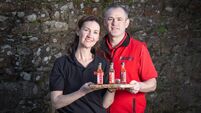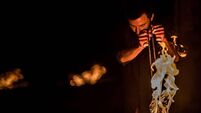Cork City and County Archives are a window to past

One of the four strong rooms at the Cork City and county archives on Great William O'Brien street. Picture: Eddie O'Hare
I was recently invited to visit the Cork City and County Archives in Blackpool as part of a workshop in which 10 artists from different backgrounds explored them.
I was invited in my capacity of being a playwright, theatre-maker and contributor to The Echo. The purpose of the workshop was to promote the archives as a resource to artists in Cork, and ultimately to spread the word about this wonderful and fascinating service to the public.
The archives are, simply put, a window to the past of Cork city and county. There is a reading room where you can explore whatever historical book, map, photos or journal you are interested in.
The building has four strong rooms where all the archived material is kept securely and safely in temperature-controlled rooms.
The archivist leading the workshop was the wonderful and informative Felix Meehan. He gave us a great insight into how the archives work, and how the materials are handled and stored. He spoke about the importance of recording our history and keeping it safe, along with the challenges of archiving, as we progress into the digital age of content.
Felix also dispelled the idea that you have to wear white gloves when you are in the archives. This is not quite the case, although some of the material is extremely old and delicate, even dating back to the 1400s, so a certain amount of care is required when handling the various pieces.
Brian Mac Domhnaill, of the Lavitt Gallery was also there to speak with us about his work using the archives, and about a photography project he worked on, which is currently on show in the reading room in the archives. His project focused on the various commemoration sites linked to the Irish War of Independence and Civil War.
His passion was evident in his deep research of the sites and history of each place. His photos were full of meaning and history and it was a beautiful way to keep in our minds the events of our ancestors here in Cork over 100 years ago.
Then we each had a chance to handle, view and read some interesting material.
Some of the pieces I looked at were the workhouse register and city jail register for the late 1800s. People of all ages were being sent to the workhouse and it feels like they never stood a chance.
We live in different times, and when someone finds themselves in a difficult position, at least now they are not being sent off to a workhouse for a hard and miserable existence. The city jail register had all manner of crimes including stealing milk, stealing cows and plenty of murder or manslaughter.
I read a personal journal of a man named Mr Foott who was keeping track of his home remedies trying to cure his hair loss. I guess Mr Foott didn’t have the option to fly to Turkey for a hair replacement.
There were articles relating to the slavery trade centred around Richmond in the USA, and the way in which people were both described and treated was nothing short of horrendous.
There were, however, many merchants here in Cork who made themselves quite wealthy by supplying the slave trade ships that would stop in the port for supplies to fuel their journey to the Americas.
I read some of the journal of Liam De Roiste, a Sinn Féin MP and a great promoter of the Irish language and the arts here in Cork. He wrote of the outbreak of World War I in his journal and he was heavily involved in politics in Cork at the time. He led an interesting life and it makes me think of how I would love to learn more about the many other men or women from that time in Cork.
The archived piece that really caught my attention was the Our Lady Of Lourdes hospital female patient register from the early 1900s. If you are not familiar with this place, it’s the very long building on the hill across the river from the Lee Fields. It has a dark history and this register gives a glimpse of why.
Women were admitted to the hospital for all manner of reasons, and even some for having high temperatures and what may be considered as a fever today, something any of us would simply go to our doctor for and get medicine to help us. Those women were not afforded that luxury and maybe the doctors or nurses there did not have the knowledge we have today.
In my teenage years, I spent time hanging around that building as it was derelict, and not far from where I grew up, a stone-throw from the football pitch we spent our summers on. Even then, it was quite haunting, with noises coming from within and a feeling that there was always someone watching you from one of the many broken windows up high.
The Cork City and County Archives is an incredible resource, but more than that, it’s a place full of stories and voices from the people who inhabited this city before we did.
The archive is a collection of facts, opinions, and inspiration. I would encourage anyone who would like to seek out some local history or anyone with an ancestor they might like to look into, to visit the Cork Archives. It is a treasure on our doorstep.







 App?
App?


